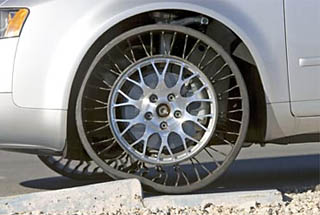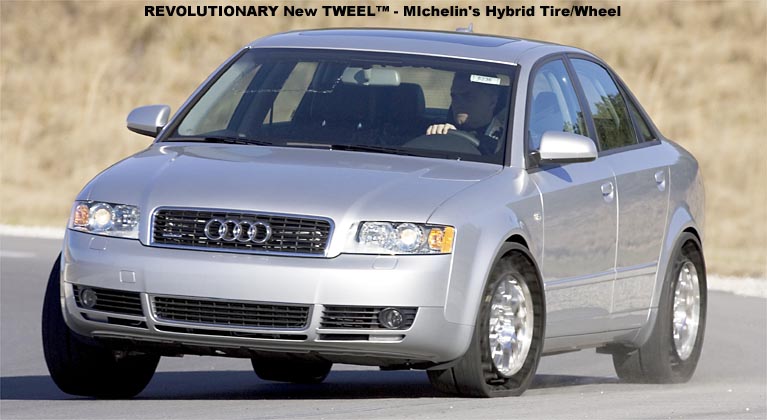|  Michelin,
the world's largest tire maker has announced a revolutionary replacement for
the air-filled tire and called it the Tweel™. A fleet of Audi cars
criss-cross Europe as part of the long term testing.The invention holds out the
promise of incredibly increased performance and is already in production.
What's so special about an engineering design that the company that invented
radial tires can get so excited? How about not using any air? Michelin's Tweel
is a radical departure from the tire we know today. Michelin,
the world's largest tire maker has announced a revolutionary replacement for
the air-filled tire and called it the Tweel™. A fleet of Audi cars
criss-cross Europe as part of the long term testing.The invention holds out the
promise of incredibly increased performance and is already in production.
What's so special about an engineering design that the company that invented
radial tires can get so excited? How about not using any air? Michelin's Tweel
is a radical departure from the tire we know today.
".... a new century has dawned and Tweel™ has proven its potential to
transform mobility. Tweel™ enables us to reach levels of performance that
quite simply aren't possible with today's conventional pneumatic
technology," says Terry Gettys, president of Michelin Americas Research
and Development Center in Greenville, S.C. "Major revolutions in mobility
may come along only once in a hundred years." "The Tweel automotive
application, as demonstrated on the Audi, is definitely a concept, an
application with strong future potential," said Gettys. "Our
concentration is to enter the market with lower-speed, lower-weight Tweel
applications. What we learn from our early successes will be applied to Tweel
fitments for passenger cars and beyond."
What Makes the Tweel™ So Special:
 The simple "hub and
spoke" design is much more than meets the eye. The secret lies in the
spokes' and wheel's ability to deform and reform to original shape. Michelin's
flexible spokes and wheel use no air, but will deliver ride characteristics
like today's pneumatic tires. So much so that the Tweel prototype, demonstrated
on the Audi A4, is within five percent of the rolling resistance and mass
levels of current pneumatic tires. That translates to within one percent of the
fuel economy of the OE fitment. Additionally, Michelin has increased the
lateral stiffness by a factor of five, making the prototype unusually
responsive in its handling. Most importantly, Michelin says the spokes and
wheel portions can be tuned independantly of each other - meaning vertical
stiffness (ride comfort) and lateral stiffness (handling and cornering) can be
adjusted to pe rformance levels not available in traditional technology. The simple "hub and
spoke" design is much more than meets the eye. The secret lies in the
spokes' and wheel's ability to deform and reform to original shape. Michelin's
flexible spokes and wheel use no air, but will deliver ride characteristics
like today's pneumatic tires. So much so that the Tweel prototype, demonstrated
on the Audi A4, is within five percent of the rolling resistance and mass
levels of current pneumatic tires. That translates to within one percent of the
fuel economy of the OE fitment. Additionally, Michelin has increased the
lateral stiffness by a factor of five, making the prototype unusually
responsive in its handling. Most importantly, Michelin says the spokes and
wheel portions can be tuned independantly of each other - meaning vertical
stiffness (ride comfort) and lateral stiffness (handling and cornering) can be
adjusted to pe rformance levels not available in traditional technology.
Don't look for this technology on the racks anytime soon. Form will follow
function in the developement cycle and it will be some time before this
technology "looks pretty". For the meantime, Michelin will take the
lessons it learns today to improve its conventional radial tire offerings.
However, in the future the Tweel may change everything we know about tires -
imagine driving a future Audi without tire pressure guages, no flats or better
yet, no blowouts. It's coming.
| Click on any image and
view a larger version. |
 |
 |
Got Questions? - Call Toll-Free - I 888 465 5835 - 1 888 GO
LLTEK
|


![]()
![]()